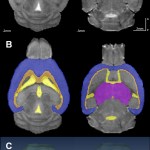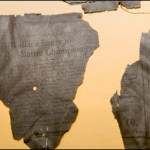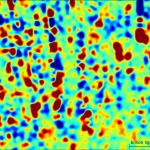
Imagine looking in the mirror and finding your familiar face reflected back as you've always known it. But as you look more closely, as you precisely examine that mirror image, subtle distortions emerge. The glass itself remains flawless, but real and fundamental differences exist between you and the face that lives on the other side of the looking glass.
Something similar happens in the quantum world when matter is examined against its exotic reflection: antimatter. The analogy is admittedly fanciful, but it's no more dramatic than the dynamics of these almost-twins, which annihilate one…
There are many complex steps to the dance of DNA replication. And scientists must learn to sway along in order to understand how both healthy and cancerous cells divide.
Scientists at Brookhaven National Laboratory have begun to learn how to follow the complex molecular choreography by which intricate cellular proteins recognize and bind to DNA to start the replication process.
The replication process starts off the same way in every cell. In the cell's DNA, there are defined sites called the "origin of replication." The cell in which the DNA is housed uses a protein called the "origin…
Brookhaven Lab atmospheric scientist Ernie Lewis with a mini "weather" balloon aboard the Horizon
This guest post was written by Ernie Lewis, an atmospheric scientist at Brookhaven Lab, who is leading a year-long climate study aboard two Horizon Lines cargo ships, the Spirit and Reliance. He recently returned from a preliminary "cruise" from L.A. to Hawaii and back aimed at assessing conditions for deploying instruments aboard the ships during the actual study, dubbed MAGIC, which will run from October 2012 through September 2013.
Hawaii was wonderful, even though I only had a…
No one credits heavy drinking with making people smarter - the mind-numbing effects are well documented. Odds are that if you haven't experienced this personally, you've witnessed it in the foolish antics of others. The clear correlation between rapidly diminishing intelligence and rising alcohol consumption is no secret.
But the long-term effects may go deeper than a morning headache or a need to wear sunglasses inside. A new study conducted at Brookhaven National Laboratory reveals that genetic factors can make some individuals more susceptible than others to lasting neurological damage…
This guest post was written by Brookhaven Lab physicist Kostas Nikolopoulos.
Today's public seminar at CERN, where the ATLAS and CMS collaborations presented the preliminary results of their searches for the Standard Model (SM) Higgs boson with the full dataset collected during 2011, is a landmark for high-energy physics!
The Higgs boson is a still-hypothetical particle postulated in the mid-1960s to complete what is considered the SM of particle interactions. Its role within the SM is to provide other particles with mass. Specifically, the mass of elementary particles is the result of their…
The Horizon Spirit, a 272-meter cargo ship, makes the round trip between Los Angeles and Hawaii every two weeks.
This is not a story about the latest mega cruise ship, with five swimming pools, 10 restaurants, a rock-climbing wall, and a casino. The vessel we're talking about, the Horizon Spirit, will be outfitted instead with radars, aerosol sampling devices, and other high-tech tools. But even without the fancy umbrella drinks, Ernie Lewis, an atmospheric scientist at the U.S. Department of Energy's (DOE) Brookhaven National Laboratory, can't wait to set sail.
Last month, he and several…
This guest post was written by Mona S. Rowe, science writer for Brookhaven National Laboratory's National Synchrotron Light Source (NSLS) and NSLS-II.
The quest to authenticate an unknown Rembrandt painting, titled "Old Man with a Beard," hit a dramatic high at the National Synchrotron Light Source (NSLS) at Brookhaven National Laboratory. Using an advanced x-ray detector developed at NSLS, scientists found compelling evidence that the famous Dutch master did indeed have his own hand on the painting.
"After doing the experiments at NSLS, I felt that the painting I held in my hands was a…
This guest post was written by Pat Looney, chair of the Sustainable Energy Technology Department at the U.S. Department of Energy's (DOE) Brookhaven National Laboratory.
If the sun is shining over Long Island, NY, as you read this article, the Long Island Solar Farm (LISF) is generating enough clean solar energy to power as many as 4,500 homes for the Long Island Power Authority (LIPA).
Construction of the LISF at Brookhaven National Laboratory (BNL) began in the fall of 2010 and officially concluded this month when the array began commercial operation. LIPA hosted a formal commissioning…
This guest post was written by Brookhaven Lab science writing intern Kenrick Vezina, who will be sharing Brookhaven science stories from inside and outside laboratories on site through mid December.
I'm about to enter the well-worn, vegetation-free (read: tick-free) pathway that cuts through the forest near my dorm. I'm about two steps down the trail when I hear a screech from somewhere in the canopy overhead. It's not the full-out war cry of a red-tailed hawk -- the sound we've been trained by television to expect from the beak of every bird of prey -- but it definitely sounds like a raptor…
Jason Graetz, left, and Jiajun Chen at NSLS beamline X14A with their transparent reactor for viewing chemistry in real time.
Here's a recipe for basic chemistry: Mix a bunch of stuff in a reaction vessel and see what happens. Only you don't really see the action taking place -- unless you have some way to visualize the molecular magic.
Researchers at Brookhaven National Laboratory have developed just such a technique: They've fabricated a transparent chemical reactor vessel that allows x-rays to pass through and capture the chemical changes as they take place.
They recently used this…
The following guest post was written by Wei-Qiang Han, a materials scientist working at Brookhaven Lab's Center for Functional Nanomaterials.
Wei-Qiang Han
With gasoline prices still hovering near $4 per gallon, scientists at Brookhaven Lab's Center for Functional Nanomaterials (CFN) are helping to develop electric vehicles capable of driving hundreds of miles on a single charge. A new compound of five tin atoms and one iron atom (FeSn5) created at the CFN is another development along the road to higher capacity lithium-ion batteries for those vehicles of the future.
Compared to other…
This guest post was written by Brookhaven Lab science writing intern Kenrick Vezina, who joined our team this month and will be sharing Brookhaven science stories from inside and outside laboratories on site through mid December.
On Saturday, September 10, I rode into Brookhaven National Laboratory for the first time. Within two hours, I was watching a handful of white-tailed deer on a strip of grass near the Princeton Avenue gate.
I'm a new intern in the Lab's Media & Communications Office, fresh from MIT's Graduate Program in Science Writing, here to report on all of the fascinating…
This guest post is by Brookhaven Lab physicist Steve Kettell, the Chief Scientist for the U.S. Daya Bay Neutrino Project in southern China. Kettell received his Ph.D. in 1990 from Yale University and is the leader of Brookhaven's Electronic Detector Group.
Steve Kettell
Neutrinos are downright weird!
Produced in prodigious numbers in the sun, supernovae, nuclear reactors and particle accelerators, neutrinos are extremely hard to detect because they hardly interact with other material at all.
If we think about photons from the sun hitting blacktop during the summer, it is quite obvious…
At first glance, this video might look like it's playing in reverse. But don't worry, these stroboscopic images were patched together in the right order.
Courtesy of Labcyte, Inc.
The video shows a technique called acoustic drop ejection (ADE) - an idea based on sending ultrasonic waves near the surface of a liquid to eject very small droplets. First demonstrated in the early 1920s, ADE is now being used by researchers to help them study extremely small biological molecules - like proteins and viruses - with x-rays at machines like Brookhaven's future National Synchrotron Light Source…
Hair breaks. It singes. It falls out. It might not be the strongest feature of living human bodies, but hair is one of the best-preserved tissues of dead ones, providing a record of diet, age, metabolism, and, sometimes, even the cause of death.
Ferdinand II*
With intense beams of x-rays at Brookhaven's National Synchrotron Light Source (NSLS), a team of researchers is using hair samples collected from the decomposed bodies of two 15th century Italian royalty to determine how they really died.
The subjects: Ferdinand II (1467-1496)* and Isabella (1470-1524) of Aragon, a medieval kingdom…
This guest post is written by Stephen R. Springston, an atmospheric chemist at Brookhaven National Laboratory. After receiving his Ph.D. in chemistry from Indiana University, he completed a postdoctoral fellowship at the University of Utah before joining Brookhaven in 1986.
Stephen Springston
After studying clouds and climate in Oklahoma during tornado season and storms atop Colorado mountaintops, a group of atmospheric scientists from Brookhaven National Laboratory will soon be helping to sample the skies over India.
We've been asked to share our expertise on conducting ground and…
Brookhaven will soon be home to the largest solar farm in the eastern United States. The Long Island Solar Farm, being constructed by BP Solar and the Long Island Power Authority on Brookhaven Lab's campus, will produce 32 megawatts of power when complete - enough to power about 4,500 homes.
The Long Island Solar Farm
Just about six months after site preparation work began in November, the farm is now more than halfway complete. To date, workers have mounted nearly 90,000 of the 164,000 solar panels that will make up the array and have installed 4,600 of the 6,800 racks that hold the…
In news that may shake the cranberry juice industry to its core, new atomic-level "snapshots" reveal how bacteria such as E. coli produce and secrete sticky appendages called pili, which help the microbes attach to and infect human bladder cells.
These crystal structures -- produced at the National Synchrotron Light Source (NSLS) at Brookhaven Lab and the European Synchrotron Radiation Facility in Grenoble, France -- unravel a complex choreography of protein-protein interactions that will aid in the design of new antibacterial drugs. Finding ways to interfere with pili formation could help…
Five years before becoming fully operational, Brookhaven's National Synchrotron Light Source II (NSLS-II) already is leading to discoveries -- of the historical kind.
Pieces of newspaper dug up at the NSLS-II construction site, which include a story about a boxing match scheduled for October 2, 1917 - Tommy Tuohey versus Ed Wallace
As earthwork takes place on the NSLS-II construction site, which housed part of the U.S. Army's Camp Upton in the World War I and II era, artifacts ranging from rusted horseshoes to nearly 100-year-old pieces of newspaper are being dug up.
One of the most…
What did the universe look like 11 billion years ago? Something like this:
This image is part of the largest-ever 3-D map of the distant universe, which was released yesterday by scientists from the Sloan Digital Sky Survey III (SDSS-III) at the April meeting of the American Physical Society. Just a slice of the entire map, the image shows the distribution of intergalactic hydrogen gas: red areas have more gas, blue areas have less.
Scientists usually map the universe by looking at galaxies. But this study, which was led by Brookhaven cosmologist Anže Slosar, observed how light from…

















